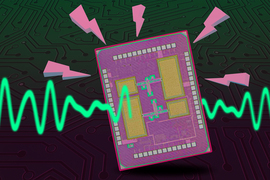Wireless receiver blocks interference for better mobile device performance
This novel circuit architecture cancels out unwanted signals at the earliest opportunity.
The growing prevalence of high-speed wireless communication devices.
from 5G mobile phones to sensors for autonomous vehicles, is leading to increasingly crowded airwaves.
This makes the ability to block interfering signals that can hamper device performance an even more important.
KEY TO THIS MIMO
Key to this MIMO receiver architecture is a special circuit .
that can target and cancel out unwanted signals. known as a nonreciprocal phase shifter.
By making a novel phase shifter structure that is reconfigurable, low-power, and compact.
the researchers show how it can be used to cancel out interference earlier in the receiver chain.
Their receiver can block up to four times more interference than some similar devices. In addition, the interference-blocking components can be switched on and off as needed to conserve energy.
In a mobile phone, such a receiver could help mitigate signal quality issues that can lead to slow.
and choppy Zoom calling or video streaming.
FREQUENCY RANGES
“There is already a lot of utilization happening in the frequency ranges.
we are trying to use for new 5G and 6G systems.
So, anything new we are trying to add should already have these interference-mitigation systems installed. Here, we’ve shown that using a nonreciprocal phase shifter in this new architecture gives us better performance.
This is quite significant, especially since .
we are using the same integrated platform as everyone else
Technology Laboratories and Research Laboratory of Electronics (RLE), and the senior author of a paper on this receiver.
The work was recently presented at the IEEE Radio Frequency Circuits Symposium and received the Best Student Paper Award.

BLOCKING INTERFERENCE
Digital MIMO systems have an analog and a digital portion.
The analog portion uses antennas to receive signals, which are amplified, down-converted.
and passed through an analog-to-digital converter before being processed in the digital domain of the device.
In this case, digital beamforming is required to retrieve the desired signal.
But if a strong, interfering signal coming from a different direction hits the receiver at the same time as a desired signal.
it can saturate the amplifier so the desired signal is drowned out.
Digital MIMOs can filter out unwanted signals, but this filtering occurs later in the receiver chain. If the interference is amplified along with the desired signal, it is more difficult to filter out later.
“The output of the initial low-noise amplifier is the first place you can do this filtering with minimal penalty.
A COMPACT DEVICE
In addition to making their novel phase shifter architecture tunable.
the researchers designed them to use less space on the chip and consume less power than typical nonreciprocal phase shifters.
Once the researchers had done the analysis to show their idea would work.
their biggest challenge was translating the theory into a circuit that achieved their performance goals.
At the same time, the receiver had to meet strict size restrictions and a tight power budget.
or it wouldn’t be useful in real-world devices.
In the end, the team demonstrated a compact MIMO architecture on a 3.2-square-millimeter chip that could block signals which were up to four times stronger than what other devices could handle.
Simpler than typical designs, their phase shifter architecture is also more energy efficient.








No comment